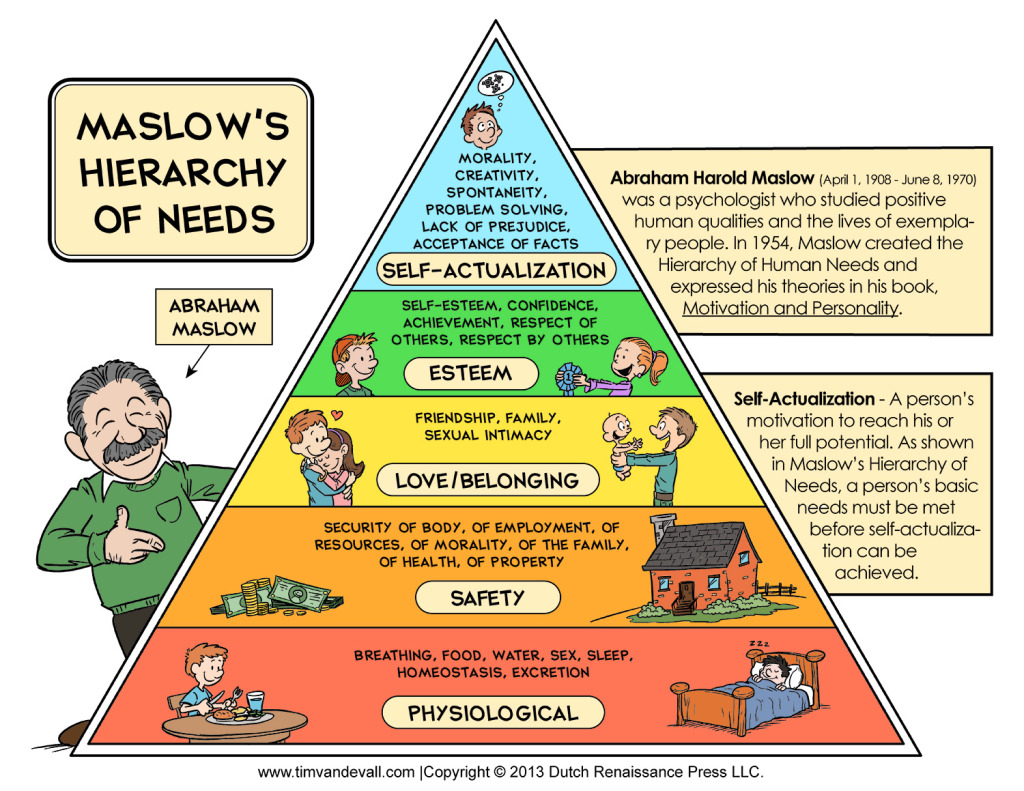Marslow’s Hierarchy of needs Theory
Togeather with development of psychology , and recognizing wide variety of human needs ,the managers in practice have ascertained and confirmed that apart from motivating their subordinate co- workers by financial motivational tools they dispose by a lot of other possibilities.The mama gets have also ascertained that these possibilities were more economocal ,but almost even much more efficient than traditional instigating of motivation by growth of wages.
Hierarchy of needs theory ,developed by the US reasercher and psychologist Abraham H.maslow in mid 20th century ,is considered to be the most renowned thory on employee motivation (Jewell,2000)
Maslow arugeus that it is innate for humans to want to satisfy their needs and raises the hypothesis that people are driven by various needs which he arranged in a certain hierachy and decided in to five levels . Author’s basic proportion is that a satisfying felt needs creates foundation of human activities and effeorts. Need to understood as a condition of keeping of physical and mental health. When dividing into different levels Maslow duplicated them as pyramids , the base of which is composed of physiological needs , placing self -realization needs at the top. It means that A . Maslow arranges needs hierarchically ,from the lowest to the highest needs , specially from a view point of an urgency with which a man experiences needs as an internal tension to the activity. “Human emotional ,cognitive ,expressive ,and esthetic always needs provide to the science its sources and its goals . A resource of a satisfying every need is a certain value ( Maslow ,1970 ) At the same time same time , Maslow perceive a man as. A psychological organisms that tries to satisfy his / her needs. These needs are arranged to the following levels (Maslow ,1968 )
Does Maslow’s hirachy of needs really work in modern Era ?..
Although maslow had levelled his theory for every human beings , needs of individuals can be distributed differently in the hierachy than presented by him ,therefore this theory was not successful in proving the hierarchy of needs and failed to take into account individual differences (Neverauskas , Rastenis , 2001). The mechanisiam of how needs are regrouped in face of certain life circumstances is unclear and the behavior of people from different countries is conditioned by different traditions and cultural experiences ,which impact the the priority motives for one’s activity and hierachy of needs, this theory can not be universally applied ( Hosfsede 1980 : Mockaitis , Salciuviene ,2003 )
Most of the provisions outlined in Maslow’s theory were not confirmed in practice , making it a questionable foundation for a motivational theory ( Newsstrom , Davis , 2000 )
Employees in real world does not satisfy their higher level needs in the work situation alone. Most of the upper level needs are satisfied by employee in other work setting. Therefore mamanger not only need to know employee behavior at work but also need to have a complete understanding of employee’s private and social life.
Employees have different preferences in satisfying their needs, based on the culture to which the employee belongs. For one employee the source of motivation may be physiological needs, while for his pear the motivation may be provided by social needs.
Some rewards satisfy more than one need at time. For expample Bonus or high salary paid to a particular employee may satisfy both lower and upper level needs . According to Maslow , satisfaction is the main motivational outcome of behavior. However job satisfaction in only one pillar of work performance and it may not lead to improved work performance.
Jewell , R.B : An intergrated Apporoch to Business studies. Logan .2000
Maslow, A.H : motivation and personality. New York . Harper & Row .1970
Maslow ,A . H : psychology of Being . New York . 1968.
Neverauskas, B- Rastenis , J : Vadybos pagrimdai , Mokomoji knyga . Kaunas Technology. 2001
Hofstede ,G : Motivation , Leadership and organization , Do American theories Apply Abroad ? Organizational Dynamics . 1980
Newstorm , J - Davis K


Comments
Post a Comment